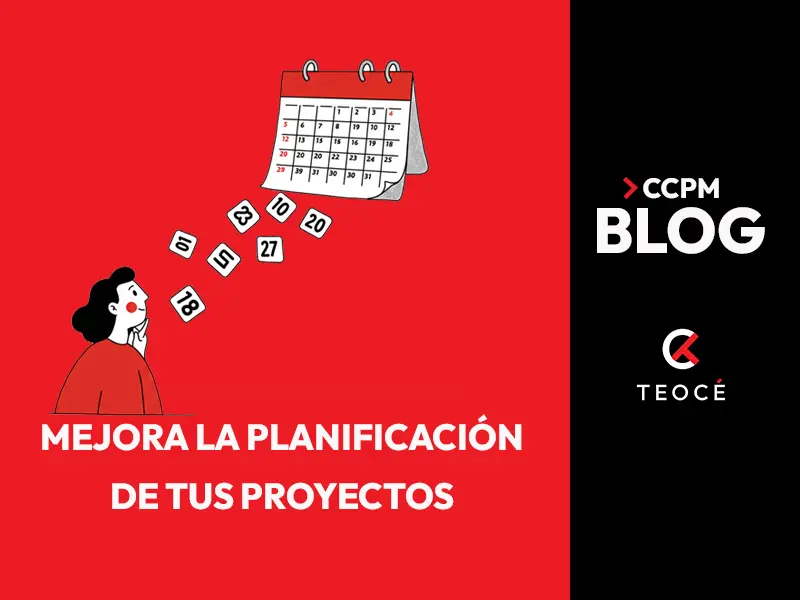Introducción
La gestión de fechas en proyectos suele parecer un tema técnico, pero en entornos multiproyecto se convierte en una fuente constante de retrasos, conflictos y presión sobre los equipos. ¿Por qué, pese a planificar fechas cuidadosamente, los proyectos siguen llegando tarde?
Este artículo explica por qué fallan las planificaciones clásicas y cómo Critical Chain Project Management (CCPM) ofrece una alternativa sólida para gestionar fechas con mayor realismo, fiabilidad y control. Hablamos desde la experiencia en entornos complejos, no desde la teoría.
Tabla de contenidos
- Introducción
- ¿Qué entendemos por gestión de fechas en proyectos?
- ¿Por qué falla la gestión de fechas en proyectos?
- Cómo se fuerzan fechas en la planificación tradicional
- Qué propone CCPM para mejorar la gestión de fechas
- 1. Aceptar la incertidumbre como parte del juego
- 2. Planificación basada en recursos reales
- 3. Buffers que protegen el compromiso, no cada tarea
- 4. Cultura de relevos
- 5. En multiproyecto, se sincroniza enfunción de la carga del recurso más saturado
- 6. Control visual con fever chart/time chart y foco en lo importante
- Beneficios tangibles del enfoque CCPM
- Conclusión: repensar la gestión de fechas en proyectos
- quieres mejorar la entregabilidad de tus proyectos?
¿Qué entendemos por gestión de fechas en proyectos?

Gestionar fechas no consiste en rellenar un calendario ni en imponer fechas límite porque «el cliente lo pide así». La gestión de fechas efectiva significa saber qué compromisos son realistas, cómo se conectan entre sí las tareas, y cuándo tiene sentido empezar o terminar algo según el flujo del proyecto.
En enfoques tradicionales, las fechas se fijan al inicio y rara vez se cuestionan. En CCPM, las fechas son el resultado de una planificación estructurada que considera duraciones realistas, disponibilidad de recursos, un margen de protección centralizado y una actualización periódica.
Esta diferencia es clave: en lugar de forzar la realidad para que encaje en un calendario, CCPM construye un calendario que refleja la realidad operativa del proyecto.
¿Por qué falla la gestión de fechas en proyectos?
Una mala gestión de fechas no solo implica retrasos. Tiene consecuencias más profundas:
- Pérdida de confianza en los planes: Si las fechas nunca se cumplen, los equipos dejan de confiar en la planificación. Empiezan a improvisar.
- Estrés y urgencias continuas: Todo parece urgente, y lo importante se diluye. Esto lleva a multitarea, fatiga y pérdida de foco.
- Clientes frustrados: Las promesas no cumplidas dañan la imagen, afectan a la percepción de calidad y generan presión comercial.
- Caos en la priorización: Cuando todos los proyectos necesitan los mismos recursos y no hay una lógica clara de secuencia, se impone el caos.
- Desaprovechamiento de adelantos: Si alguien termina antes, no lo comunica. ¿Para qué hacerlo si la fecha ya está fijada?
El error común es pensar que cuanto más rígidas las fechas, más control tendremos. En realidad, sucede lo contrario: los planes se rompen porque no pueden adaptarse a lo inesperado.
Cómo se fuerzan fechas en la planificación tradicional
Veamos ahora cómo se suelen introducir y controlar las fechas en los enfoques tradicionales de planificación. Son técnicas habituales en herramientas como MS Project, pero no siempre conducen al resultado esperado.
1. Restricciones de calendario
Herramientas como MS Project permiten asignar restricciones del tipo:
- ASAP / ALAP: situar tareas lo antes o lo más tarde posible
- MSO / MFO: obligar a que empiecen o acaben en una fecha fija
- SNET / FNLT: marcar límites de inicio o finalización
El problema no está en usarlas, sino en usarlas como estrategia de control. Estas restricciones no consideran si el recurso estará disponible ni si el trabajo podrá ejecutarse con calidad.
2. Leads y lags para forzar fechas
Una práctica habitual es utilizar relaciones como FS +120 (una tarea puede empezar 120 días después de su predecesora) para colocar tareas artificialmente. ¿La razón? Cumplir con hitos administrativos o fechas contractuales rígidas. El número (120) no responde a una lógica técnica, sino a una expectativa de entrega. Así, el plan pierde conexión con el flujo real del trabajo.
Qué propone CCPM para mejorar la gestión de fechas
Una vez visto por qué fallan tantas planificaciones y cómo los métodos tradicionales tienden a forzar las fechas, es momento de analizar en qué se diferencia CCPM. Este enfoque no solo propone herramientas distintas, sino una lógica radicalmente opuesta para gestionar la planificación y sus fechas clave.
1. Aceptar la incertidumbre como parte del juego

CCPM reconoce que las tareas no siempre salen como se espera. En lugar de esconderlo, lo gestiona de forma estructurada:
- Se planifica las tareas con una estimación sin protección (Focus Duration)
- La protección se traslada a Buffers centralizados (Buffer de Proyecto) que absorben imprevistos
Esto permite tener una planificación ágil y realista, sin caer en la ilusión de que todo saldrá perfecto.
2. Planificación basada en recursos reales
La Cadena Crítica no es solo la ruta más larga del proyecto: es la ruta más larga que considera también la disponibilidad de recursos compartidos. Así se evita sobrecargar a los equipos y se ajustan los tiempos a la capacidad real.
3. Buffers que protegen el compromiso, no cada tarea
En lugar de inflar cada tarea con márgenes de seguridad ocultos, CCPM concentra esa protección en Buffers visibles. Esto permite saber cuándo el proyecto está en riesgo, y tomar decisiones a tiempo.
4. Cultura de relevos
En CCPM, cada tarea terminada antes de tiempo sí aporta al proyecto. No se espera a que llegue la fecha prevista para pasar al siguiente. Se trabaja como en una carrera de relevos: lo importante es pasar el testigo lo antes posible.
5. En multiproyecto, se sincroniza enfunción de la carga del recurso más saturado
Cuando varios proyectos compiten por los mismos recursos, CCPM identifica cuál marca el ritmo (el Pacing Resource). A partir de ahí, organiza los planes y deja Buffers entre tareas para absorber variaciones sin desestabilizar todo el sistema.
6. Control visual con fever chart/time chart y foco en lo importante
El seguimiento no se basa en fechas previstas, sino en el consumo del Buffer. Si el proyecto avanza más rápido que el Buffer, vamos bien. Si no, hay que actuar. Además, cada persona sabe qué tarea es prioritaria cada día.
Beneficios tangibles del enfoque CCPM
Para evaluar si un cambio de enfoque merece la pena, conviene analizar los resultados concretos que se pueden obtener. CCPM no solo cambia la manera de planificar, sino que mejora visiblemente los resultados operativos y de negocio. Estos son algunos de los beneficios más observados en organizaciones que adoptan este modelo:
- Plazos más cortos sin sacrificar calidad
- Mayor capacidad para ejecutar más proyectos con los mismos recursos
- Cumplimiento sistemático de fechas clave
- Menos estrés y más colaboración
- Visibilidad en tiempo real del estado del proyecto
- Capacidad de aprendizaje y mejora continua
Conclusión: repensar la gestión de fechas en proyectos
Volvamos a la pregunta del inicio: ¿por qué tu planificación falla con las fechas?
La respuesta está en el enfoque. Si las fechas se introducen como una imposición externa, despegada del flujo real de trabajo y de la disponibilidad de recursos, el plan se convierte en una fuente de tensión en lugar de una herramienta de gestión.
CCPM ofrece una lógica diferente. Parte de aceptar la incertidumbre, organiza el trabajo en función de la realidad operativa y protege los compromisos con buffers dinámicos. Así, las fechas no se imponen: se construyen desde el sistema y se controlan con criterios claros.

Planificar bien no es acertar el día exacto de cada tarea. Es garantizar que el conjunto del proyecto avanza con fluidez, que el equipo mantiene el foco y que los compromisos con el cliente se cumplen con fiabilidad.
¿Te interesa profundizar en este enfoque? Contáctanos o visita el resto de artículos de este blog
quieres mejorar la entregabilidad de tus proyectos?
Aplica CCPM con el respaldo de Teocé. Te guiamos para:
- Detectar cuellos de botella y sincronizar recursos.
- Rediseñar tu planificación con buffers efectivos.
- Ejecutar con foco, control visual y sin añadir urgencias.
